Genome-Wide Identification, Characterization, and Transcriptomic Analysis of the Cyclin Gene Family in Brassica rapa
Abstract
:1. Introduction
2. Results
2.1. Identification of the Cyclin Gene Family in Brassica rapa
2.2. Cyclin Gene Structure and the Conserved Domain and Motif Analysis
2.3. Comparative Phylogenetic Analysis and Classification of the B. rapa Cyclin Gene
2.4. Duplication Event in the Brassica rapa Cyclins and Synteny Analysis
2.5. Cis-Elements in the Promoters of the Brassica rapa Cyclin Genes
2.6. 3D Protein Structure of the Cyclin Genes in Brassica rapa
2.7. Genome-Wide Analysis of the miRNA Targeting Cyclin Genes in Brassica rapa
2.8. Functional Annotation Analysis of the Cyclin Genes in Brassica rapa
2.9. The Functional Characterization of the Brassica rapa Cyclin Genes by the SNP Analysis
2.10. Expression Profiles of the Brassica rapa Cyclin Genes by a Transcriptome Analysis
3. Discussion
3.1. Identification of the Cyclin Gene Family and Its Structure in Brassica rapa
3.2. Segmental Duplication Event of the Brassica rapa Cyclins
3.3. MicroRNAs Targeting the Cyclin Genes in Brassica rapa
3.4. Expression Profiles of the Brassica rapa Cyclin Genes by Analyzing the Transcriptomic Data
4. Material and Method
4.1. Identification and Characterization of the Cyclin Gene Family
4.2. Comparative Phylogenetic Analysis and Classification of the Brassica rapa Cyclin Gene
4.3. Tandem Duplication Events of the Brassica rapa Cyclins and the Synteny Analysis
4.4. Cis-Elements in the Promoters of the Brassica rapa Cyclin Genes
4.5. 3D Protein Structure of the Cyclin Gene in Brassica rapa
4.6. Cyclin Gene Structure, Conserved Domain, and the Motif Analysis
4.7. Genome-Wide Analysis of the miRNA Targeting the Cyclin Genes in Brassica rapa
4.8. Functional Annotation Analysis of the Brcyclin genes
4.9. Analyzing the Transcriptomic Data and the Single Nucleotide Polymorphisms to Determine the Functional Characterization of the Brassica rapa Cyclin Genes
4.9.1. Plant Growth and RNA Sample Collection
4.9.2. RNA-Seq Library Construction and Sequencing
4.9.3. Differential Expression and Cluster Analysis
4.9.4. Single Nucleotide Polymorphisms (SNP) Analysis
5. Conclusions
Supplementary Materials
Author Contributions
Funding
Institutional Review Board Statement
Informed Consent Statement
Data Availability Statement
Acknowledgments
Conflicts of Interest
References
- Eloy, N.B.; Lima, M.D.F.; Ferreira, P.C.; Inzé, D. The role of the anaphase-promoting complex/cyclosome in plant growth. Crit. Rev. Plant Sci. 2015, 34, 487–505. [Google Scholar] [CrossRef] [Green Version]
- Banerjee, G.; Singh, D.; Sinha, A.K. Plant cell cycle regulators: Mitogen-activated protein kinase, a new regulating switch? Plant Sci. 2020, 301, 110660. [Google Scholar] [CrossRef] [PubMed]
- Hata, S.; Kouchi, H.; Suzuka, I.; Ishii, T. Isolation and characterization of cDNA clones for plant cyclins. EMBO J. 1991, 10, 2681–2688. [Google Scholar] [CrossRef]
- Inzé, D.; De Veylder, L. Cell cycle regulation in plant development. Annu. Rev. Genet. 2006, 40, 77–105. [Google Scholar] [CrossRef] [PubMed]
- Nugent, J.; Alfa, C.; Young, T.; Hyams, J. Conserved structural motifs in cyclins identified by sequence analysis. J. Cell Sci. 1991, 99, 669–674. [Google Scholar] [CrossRef] [PubMed]
- Horne, M.C.; Goolsby, G.L.; Donaldson, K.L.; Tran, D.; Neubauer, M.; Wahl, A.F. Cyclin G1 and Cyclin G2 Comprise a New Family of Cyclins with Contrasting Tissue-specific and Cell Cycle-regulated Expression (∗). J. Biol. Chem. 1996, 271, 6050–6061. [Google Scholar] [CrossRef] [PubMed] [Green Version]
- Wang, G.; Kong, H.; Sun, Y.; Zhang, X.; Zhang, W.; Altman, N.; Depamphilis, C.W.; Ma, H. Genome-wide analysis of the cyclin family in Arabidopsis and comparative phylogenetic analysis of plant cyclin-like proteins. Plant Physiol. 2004, 135, 1084–1099. [Google Scholar] [CrossRef] [PubMed] [Green Version]
- Reichheld, J.-P.; Chaubet, N.; Shen, W.H.; Renaudin, J.-P.; Gigot, C. Multiple A-type cyclins express sequentially during the cell cycle in Nicotiana tabacum BY2 cells. Proc. Natl. Acad. Sci. USA 1996, 93, 13819–13824. [Google Scholar] [CrossRef] [Green Version]
- Yu, Y.; Steinmetz, A.; Meyer, D.; Brown, S.; Shen, W.-H. The tobacco A-type cyclin, Nicta;CYCA3;2, at the nexus of cell division and differentiation. Plant Cell 2003, 15, 2763–2777. [Google Scholar] [CrossRef] [Green Version]
- Inzé, D.; Gutiérrez, C.; Chua, N.H. Trends in plant cell cycle research. Plant Cell 1999, 11, 991–994. [Google Scholar] [CrossRef]
- Boudolf, V.; Lammens, T.; Boruc, J.; Van Leene, J.; Van Den Daele, H.; Maes, S.; Van Isterdael, G.; Russinova, E.; Kondorosi, E.; Witters, E.; et al. CDKB1;1 forms a functional complex with CYCA2;3 to suppress endocycle onset. Plant Physiol. 2009, 150, 1482–1493. [Google Scholar] [CrossRef] [Green Version]
- Boudolf, V.; Vlieghe, K.; Beemster, G.; Magyar, Z.; Acosta, J.A.T.; Maes, S.; Van Der Schueren, E.; Inzé, D.; De Veylder, L. The plant-specific cyclin-dependent kinase CDKB1; 1 and transcription factor E2Fa-DPa control the balance of mitotically dividing and endoreduplicating cells in Arabidopsis. Plant Cell 2004, 16, 2683–2692. [Google Scholar] [CrossRef] [Green Version]
- Weimer, A.K.; Biedermann, S.; Harashima, H.; Roodbarkelari, F.; Takahashi, N.; Foreman, J.; Guan, Y.; Pochon, G.; Heese, M.; Van Damme, D.; et al. The plant-specific CDKB 1-CYCB 1 complex mediates homologous recombination repair in Arabidopsis. EMBO J. 2016, 35, 2068–2086. [Google Scholar] [CrossRef]
- Menges, M.; Samland, A.K.; Planchais, S.; Murray, J.A. The D-type cyclin CYCD3; 1 is limiting for the G1-to-S-phase transition in Arabidopsis. Plant Cell 2006, 18, 893–906. [Google Scholar] [CrossRef] [PubMed] [Green Version]
- Hu, X.; Cheng, X.; Jiang, H.; Zhu, S.; Cheng, B.; Xiang, Y. Genome-wide analysis of cyclins in maize (Zea mays). Genet. Mol. Res. 2010, 9, 1490–1503. [Google Scholar] [CrossRef]
- Perrot-Rechenmann, C. Cellular responses to auxin: Division versus expansion. Cold Spring Harb. Perspect. Biol. 2010, 2, a001446. [Google Scholar] [CrossRef] [PubMed]
- Pooggin, M.M. How can plant DNA viruses evade siRNA-directed DNA methylation and silencing? Int. J. Mol. Sci. 2013, 14, 15233–15259. [Google Scholar] [CrossRef] [PubMed] [Green Version]
- Dewitte, W.; Scofield, S.; Alcasabas, A.A.; Maughan, S.C.; Menges, M.; Braun, N.; Collins, C.; Nieuwland, J.; Prinsen, E.; Sundaresan, V.; et al. Arabidopsis CYCD3 D-type cyclins link cell proliferation and endocycles and are rate-limiting for cytokinin responses. Proc. Natl. Acad. Sci. USA 2007, 104, 14537–14542. [Google Scholar] [CrossRef] [Green Version]
- Hemerly, A.; Engler, J.D.A.; Bergounioux, C.; Van Montagu, M.; Engler, G.; Inzé, D.; Ferreira, P. Dominant negative mutants of the Cdc2 kinase uncouple cell division from iterative plant development. EMBO J. 1995, 14, 3925–3936. [Google Scholar] [CrossRef]
- Meng, J.; Peng, M.; Yang, J.; Zhao, Y.; Hu, J.; Zhu, Y.; He, H. Genome-wide analysis of the cyclin gene family and their expression profile in Medicago truncatula. Int. J. Mol. Sci. 2020, 21, 9430. [Google Scholar] [CrossRef]
- Zhang, T.; Wang, X.; Lu, Y.; Cai, X.; Ye, Z.; Zhang, J. Genome-wide analysis of the cyclin gene family in tomato. Int. J. Mol. Sci. 2013, 15, 120–140. [Google Scholar] [CrossRef] [Green Version]
- Qi, F.; Zhang, F. Cell cycle regulation in the plant response to stress. Front. Plant Sci. 2020, 10, 1765. [Google Scholar] [CrossRef] [Green Version]
- Cui, X.; Fan, B.; Scholz, J.; Chen, Z. Roles of Arabidopsis cyclin-dependent kinase C complexes in cauliflower mosaic virus infection, plant growth, and development. Plant Cell 2007, 19, 1388–1402. [Google Scholar] [CrossRef] [PubMed] [Green Version]
- Liu, S.; Liu, Y.; Yang, X.; Tong, C.; Edwards, D.; Parkin, I.A.P.; Zhao, M.; Ma, J.; Yu, J.; Huang, S.; et al. The Brassica oleracea genome reveals the asymmetrical evolution of polyploid genomes. Nat. Commun. 2014, 5, 3930. [Google Scholar] [CrossRef] [PubMed] [Green Version]
- Cannon, S.B.; Mitra, A.; Baumgarten, A.; Young, N.D.; May, G. The roles of segmental and tandem gene duplication in the evolution of large gene families in Arabidopsis thaliana. BMC Plant Biol. 2004, 4, 10. [Google Scholar] [CrossRef] [Green Version]
- Sun, G. MicroRNAs and their diverse functions in plants. Plant Mol. Biol. 2012, 80, 17–36. [Google Scholar] [CrossRef]
- Debernardi, J.M.; Mecchia, M.A.; Vercruyssen, L.; Smaczniak, C.; Kaufmann, K.; Inze, D.; Rodriguez, R.E.; Palatnik, J.F. Post-transcriptional control of GRF transcription factors by micro RNA miR396 and GIF co-activator affects leaf size and longevity. Plant J. 2014, 79, 413–426. [Google Scholar] [CrossRef] [PubMed]
- Mallory, A.C.; Reinhart, B.J.; Jones-Rhoades, M.W.; Tang, G.L.; Zamore, P.D.; Barton, M.K.; Bartel, D.P. MicroRNA control of PHABULOSA in leaf development: Importance of pairing to the microRNA 5′ region. EMBO J. 2004, 23, 3356–3364. [Google Scholar] [CrossRef] [Green Version]
- Klesen, S.; Hill, K.; Timmermans, M.C. Timmermans, Small RNAs as plant morphogens. Curr. Top. Dev. Biol. 2020, 137, 455–480. [Google Scholar]
- Sun, X.; Li, X.; Lu, Y.; Wang, S.; Zhang, X.; Zhang, K.; Su, X.; Liu, M.; Feng, D.; Luo, S.; et al. Construction of a high-density mutant population of Chinese cabbage facilitates the genetic dissection of agronomic traits. Mol. Plant 2022, 15, 913–924. [Google Scholar] [CrossRef]
- Corneillie, S.; De Storme, N.; Van Acker, R.; Fangel, J.U.; De Bruyne, M.; De Rycke, R.; Geelen, D.; Willats, W.G.T.; Vanholme, B.; Boerjan, W. Polyploidy affects plant growth and alters cell wall composition. Plant Physiol. 2019, 179, 74–87. [Google Scholar] [CrossRef] [PubMed]
- Ku, L.X.; Zhang, J.; Guo, S.L.; Liu, H.Y.; Zhao, R.F.; Chen, Y.H. Integrated multiple population analysis of leaf architecture traits in maize (Zea mays L.). J. Exp. Bot. 2012, 63, 261–274. [Google Scholar] [CrossRef] [PubMed] [Green Version]
- Ohyama, A.; Tominaga, R.; Toriba, T.; Tanaka, W. D-type cyclin OsCYCD3;1 is involved in the maintenance of meristem activity to regulate branch formation in rice. J. Plant Physiol. 2022, 270, 153634. [Google Scholar] [CrossRef] [PubMed]
- La, H.; Li, J.; Ji, Z.; Cheng, Y.; Li, X.; Jiang, S.-Y.; Venkatesh, P.N.; Ramachandran, S. Genome-wide analysis of cyclin family in rice (Oryza sativa L.). Mol. Genet. Genom. 2006, 275, 374–386. [Google Scholar] [CrossRef]
- Dong, Q.; Zhao, Y.; Jiang, H.; He, H.; Zhu, S.; Cheng, B.; Xiang, Y. Genome-wide identification and characterization of the cyclin gene family in Populus trichocarpa. Plant Cell Tissue Organ Cult. (PCTOC) 2011, 107, 55–67. [Google Scholar] [CrossRef]
- Moore, R.C.; Purugganan, M.D. The early stages of duplicate gene evolution. Proc. Natl. Acad. Sci. USA 2003, 100, 15682–15687. [Google Scholar] [CrossRef] [Green Version]
- Cui, C.; Wang, J.-J.; Zhao, J.-H.; Fang, Y.-Y.; He, X.-F.; Guo, H.-S.; Duan, C.-G. A Brassica miRNA regulates plant growth and immunity through distinct modes of action. Mol. Plant 2020, 13, 231–245. [Google Scholar] [CrossRef]
- Guo, P.; Li, Z.; Huang, P.; Li, B.; Fang, S.; Chu, J.; Guo, H. A tripartite amplification loop involving the transcription factor WRKY75, salicylic acid, and reactive oxygen species accelerates leaf senescence. Plant Cell 2017, 29, 2854–2870. [Google Scholar] [CrossRef] [Green Version]
- Li, P.; Su, T.; Zhang, D.; Wang, W.; Xin, X.; Yu, Y.; Zhao, X.; Yu, S.; Zhang, F. Genome-wide analysis of changes in miRNA and target gene expression reveals key roles in heterosis for Chinese cabbage biomass. Hortic. Res. 2021, 8, 39. [Google Scholar] [CrossRef]
- Sauter, M.; Mekhedov, S.L.; Kende, H. Gibberellin promotes histone H1 kinase activity and the expression of cdc2 and cyclin genes during the induction of rapid growth in deepwater rice internodes. Plant J. 1995, 7, 623–632. [Google Scholar] [CrossRef]
- Baekelandt, A.; Pauwels, L.; Wang, Z.; Li, N.; De Milde, L.; Natran, A.; Vermeersch, M.; Li, Y.; Goossens, A.; Inzé, D.; et al. Arabidopsis leaf flatness is regulated by PPD2 and NINJA through repression of CYCLIN D3 genes. Plant Physiol. 2018, 178, 217–232. [Google Scholar] [CrossRef]
- Gasteiger, E.; Hoogland, C.; Gattiker, A.; Wilkins, M.R.; Appel, R.D.; Bairoch, A. Protein identification and analysis tools on the ExPASy server. Proteom. Protoc. Handb. 2005, 52, 571–607. [Google Scholar]
- Tamura, K.; Peterson, D.; Peterson, N.; Stecher, G.; Nei, M.; Kumar, S. MEGA5: Molecular evolutionary genetics analysis using maximum likelihood, evolutionary distance, and maximum parsimony methods. Mol. Biol. Evol. 2011, 28, 2731–2739. [Google Scholar] [CrossRef] [PubMed] [Green Version]
- He, L.; Zhang, F.; Wu, X.; Hu, Y.; Dong, L.; Dewitte, W.; Wen, B. Genome-wide characterization and expression of two-component system genes in cytokinin-regulated gall formation in Zizania latifolia. Plants 2020, 9, 1409. [Google Scholar] [CrossRef] [PubMed]
- Mun, J.-H.; Kwon, S.-J.; Yang, T.-J.; Seol, Y.-J.; Jin, M.; Kim, J.-A.; Lim, M.-H.; Kim, J.S.; Baek, S.; Choi, B.-S.; et al. Genome-wide comparative analysis of the Brassica rapa gene space reveals genome shrinkage and differential loss of duplicated genes after whole genome triplication. Genome Biol. 2009, 10, R111. [Google Scholar] [CrossRef] [Green Version]
- Tang, H.; Bowers, J.E.; Wang, X.; Ming, R.; Alam, M.; Paterson, A.H. Synteny and collinearity in plant genomes. Science 2008, 320, 486–488. [Google Scholar] [CrossRef] [Green Version]
- Chenghe, Z. Inducement of autotetraploid Chinese cabbage (Brassica var. communis Tsen et Lee) and its cytological study. Hebei Nongye Daxue Xuebao 1999, 22, 53–56. [Google Scholar]
- Gu, A.X.; Shen, S.X.; Wang, Y.H.; Zhao, J.J.; Xuan, S.X.; Chen, X.P.; Li, X.F.; Luo, S.X.; Zhao, Y.J. Generation and characterization of Brassica rapa ssp. pekinensis–B. oleracea var. capitata monosomic and disomic alien addition lines. J. Genet. 2015, 94, 435–444. [Google Scholar] [CrossRef]
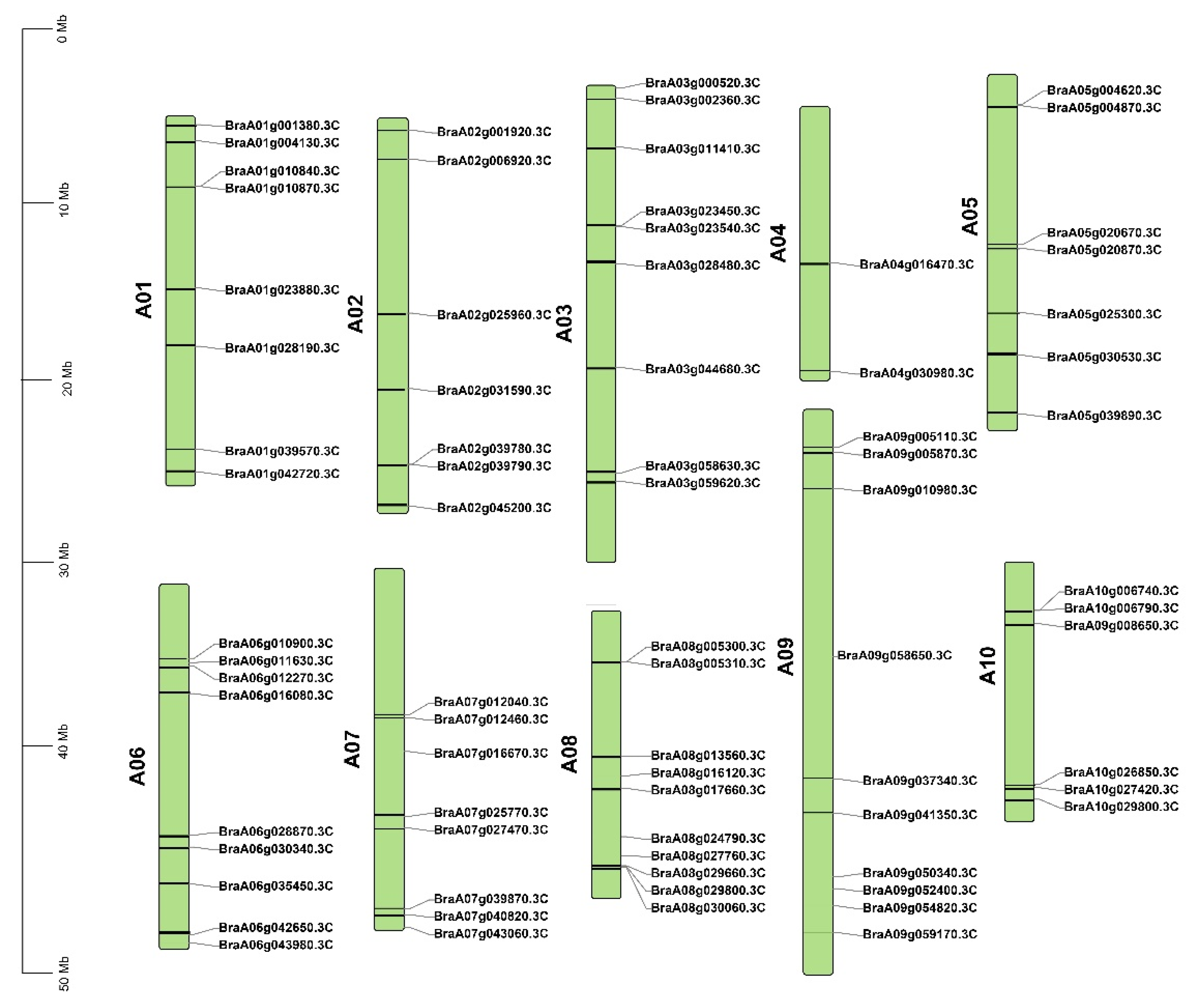

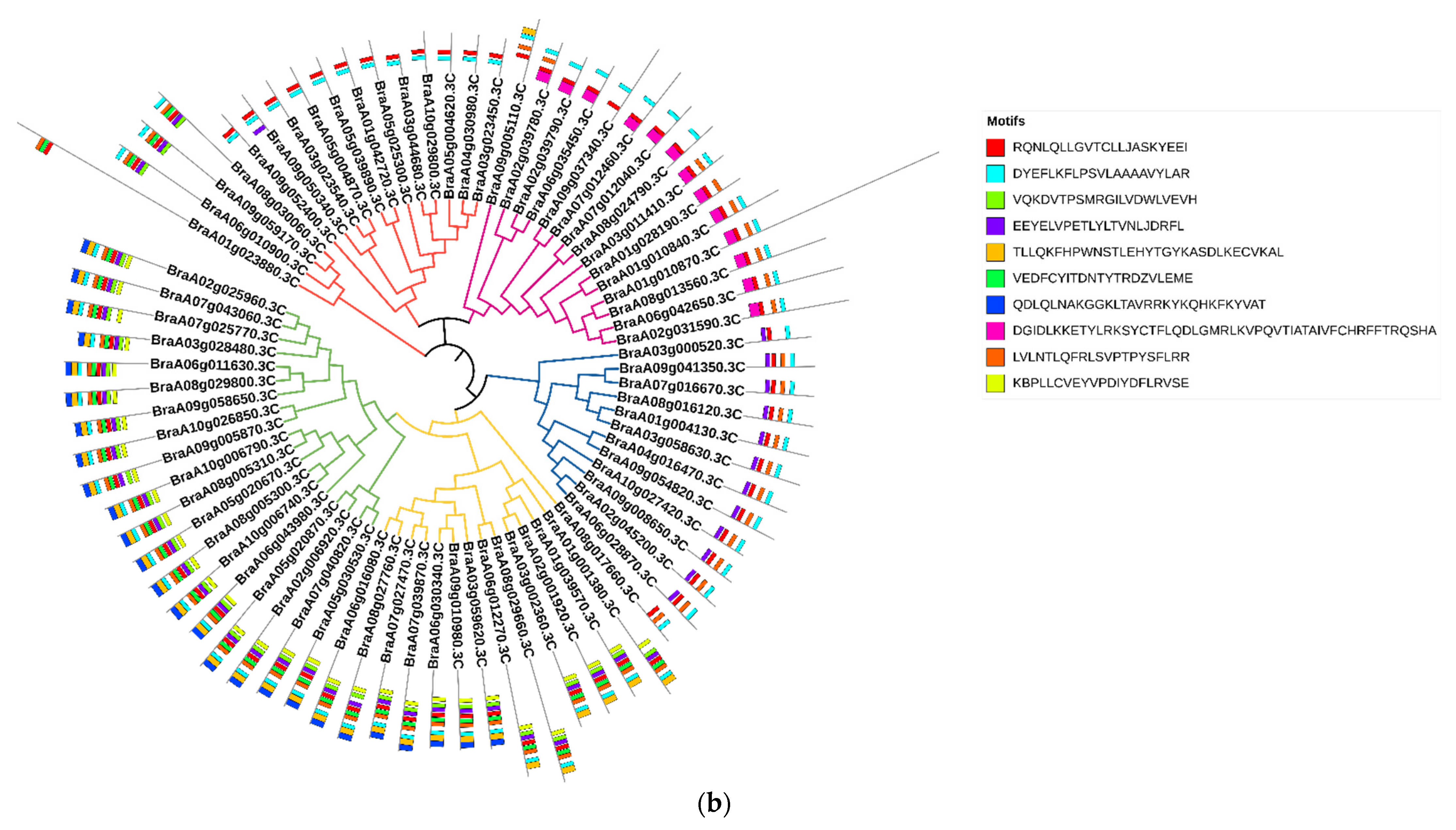


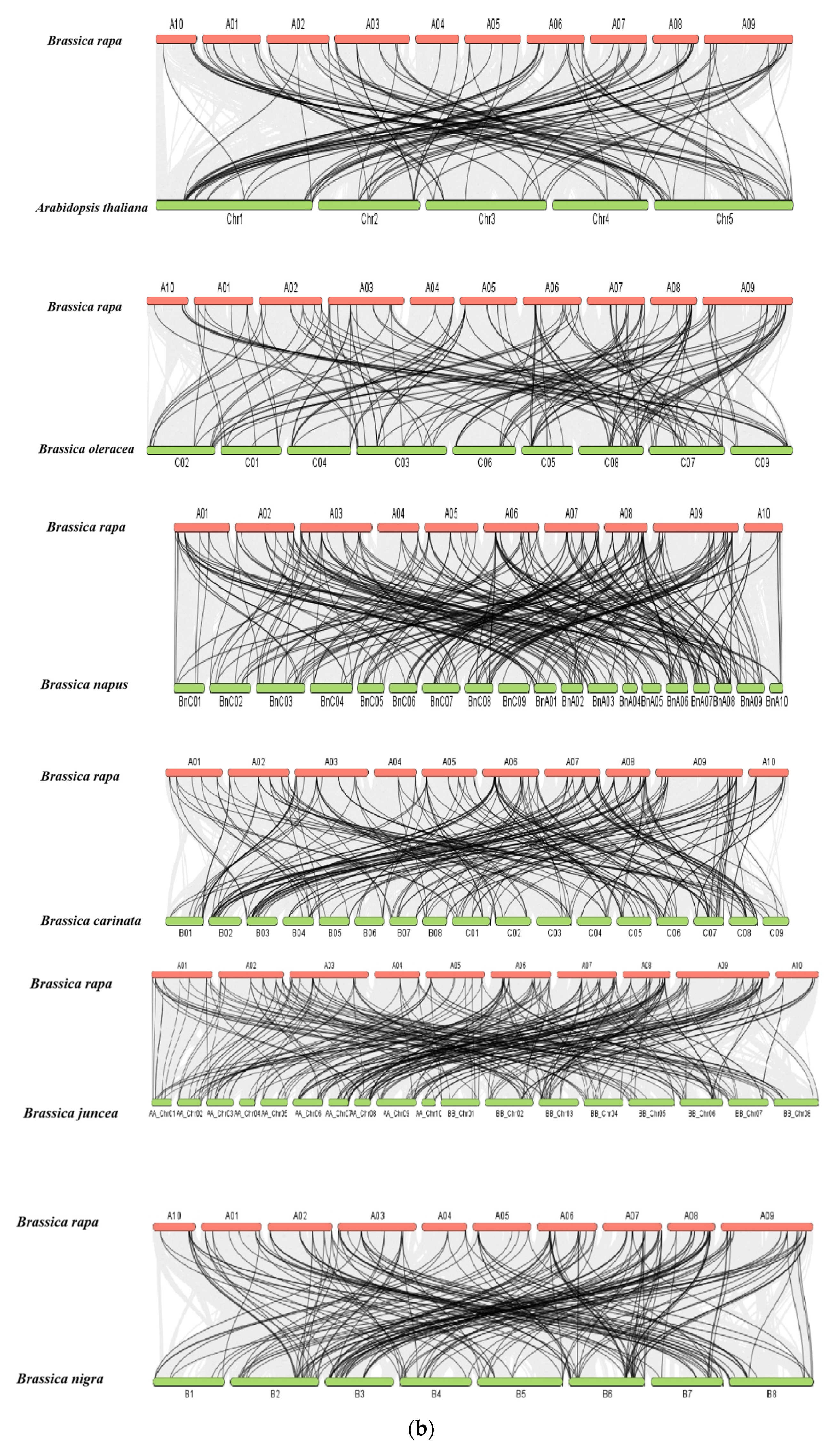

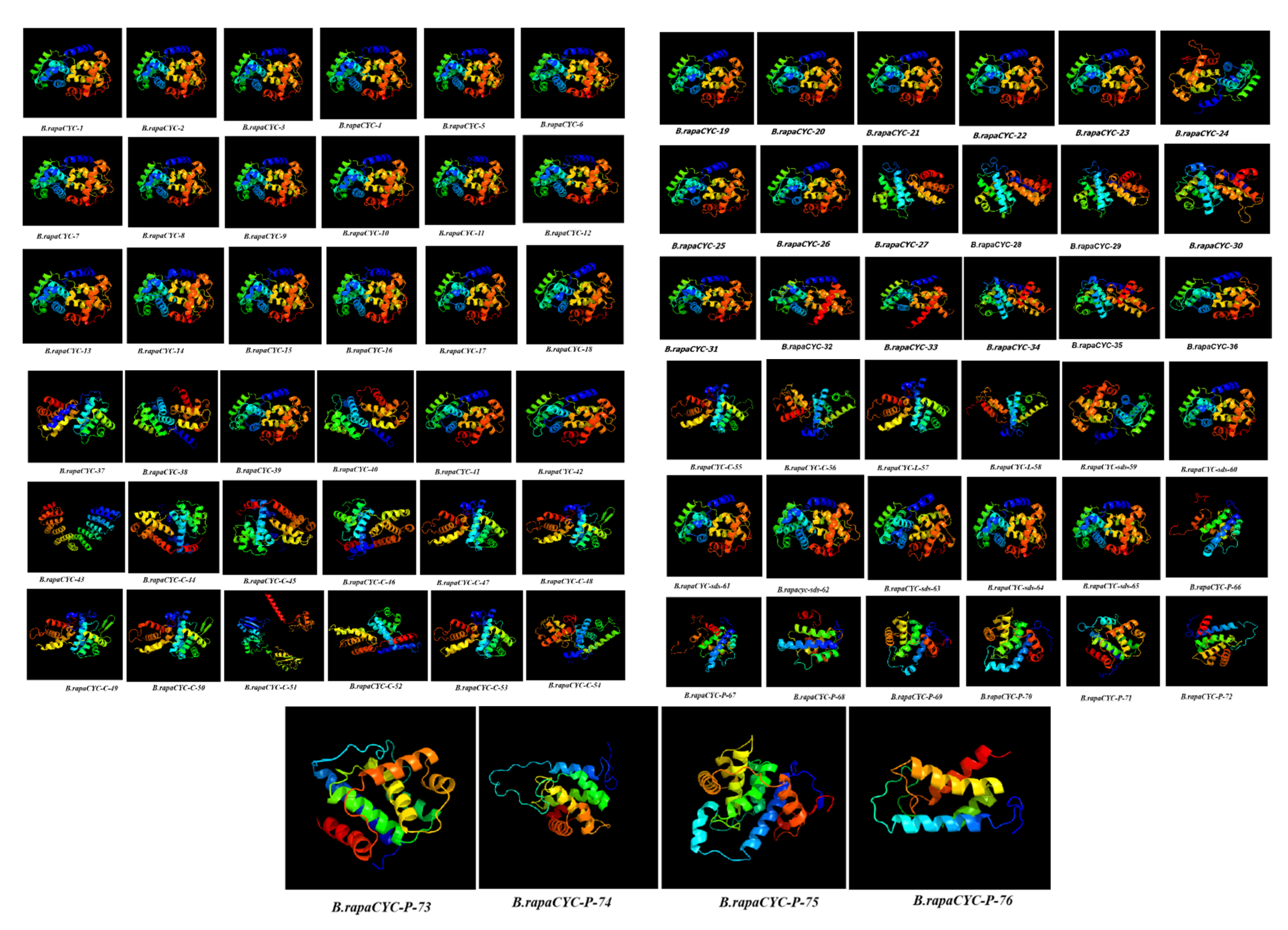



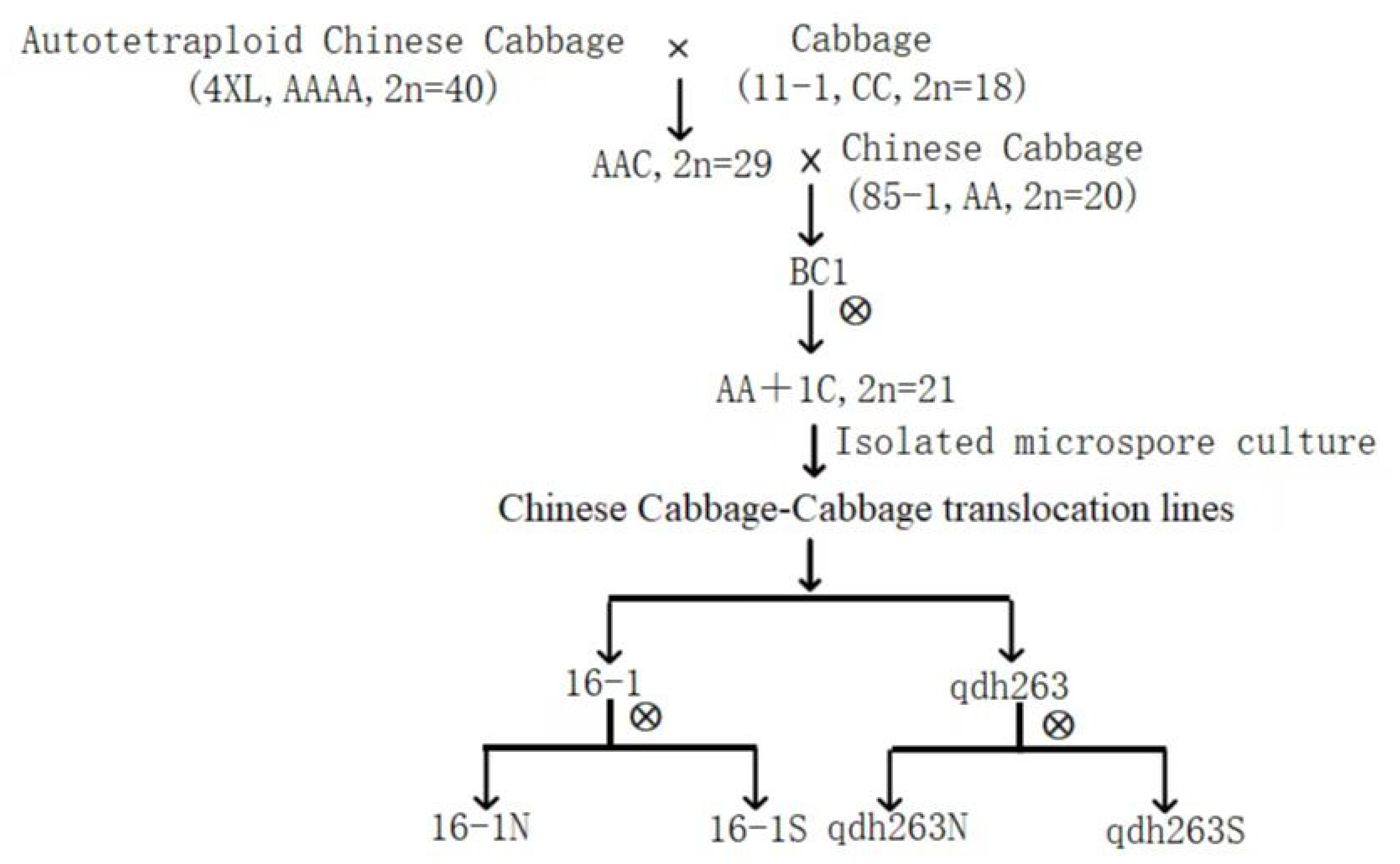
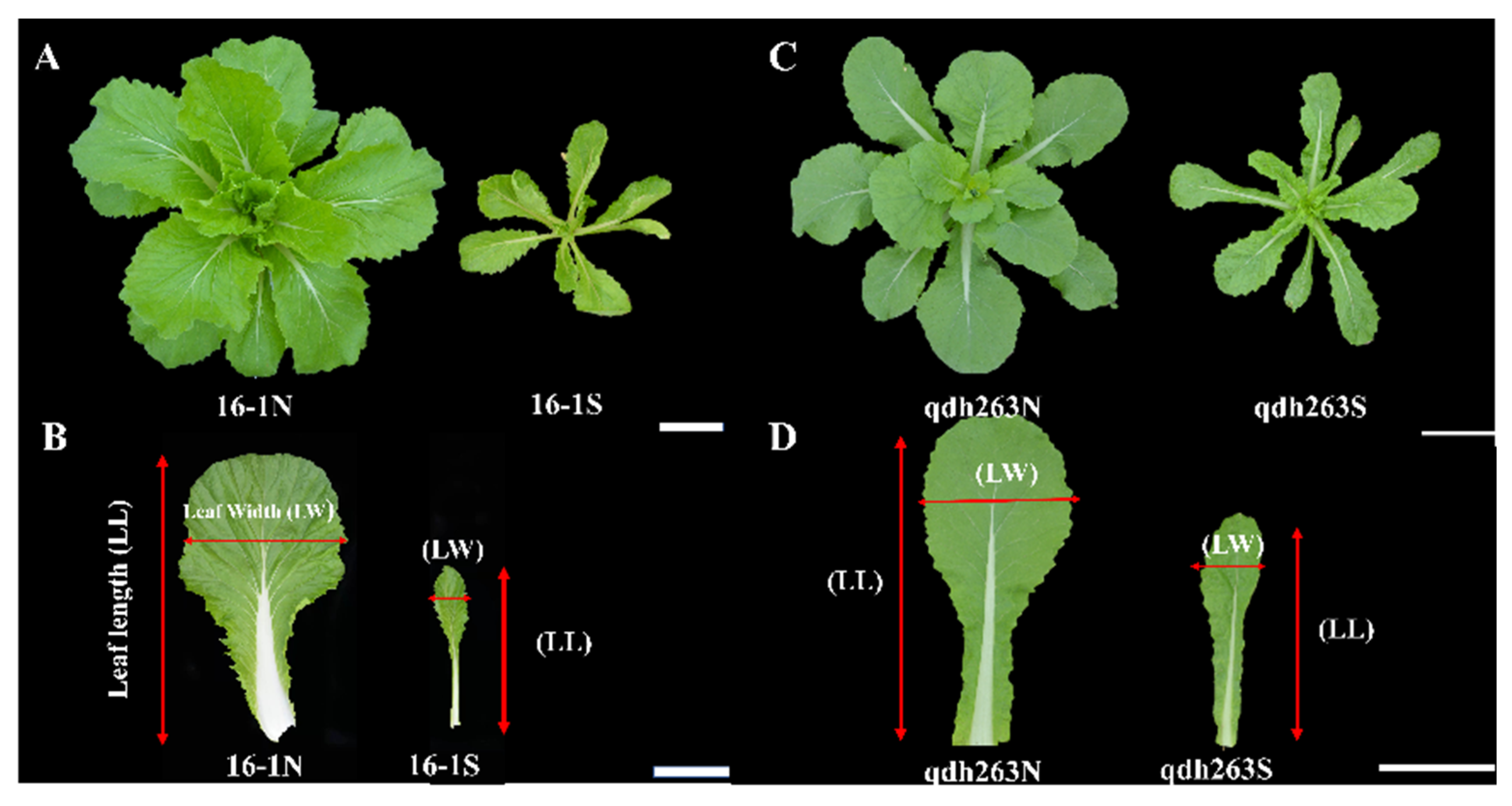
| Transcript ID | Gene Name | Given Name | Chr Position | Location Start-End | Strand | CDS (BP) | Instability Index | Amino Acid | PI | GRAVY | Intron, Exon | Sub-Cellular Localization | Molecular Weight |
|---|---|---|---|---|---|---|---|---|---|---|---|---|---|
| BraA05g020870.3C | CYCA1;1; CYCLIN A1;1 | B. rapaCYC-1 | A05 | 13,877,912–13,880,523 | Positive | 1332 | 54.22 | 443 | 6.06 | −0.357 | 9, 10 | Nuclear | 50,140.08 |
| BraA02g006920.3C | CYCA1;1; CYCLIN A1;1 | B. rapaCYC-2 | A02 | 3,270,499–3,272,381 | Positive | 1281 | 56.27 | 426 | 8.23 | −0.345 | 7, 8 | Nuclear | 47,913.92 |
| BraA07g040820.3C | CYCA1; CYCA1;2; CYCLIN A1; CYCLIN A1;2; DYP; TAM; TARDY ASYNCHRONOUS MEIOSIS | B. rapaCYC-3 | A07 | 27,632,105–27,634,004 | Negative | 1161 | 54.03 | 386 | 7.5 | −0.288 | 9, 10 | Nuclear | 43,398.62 |
| BraA10g026850.3C | - | B. rapaCYC-4 | A10 | 17,761,806–17,764,332 | Positive | 1314 | 53 | 437 | 5.71 | −0.314 | 11, 12 | Nuclear | 49,155.22 |
| BraA06g011630.3C | CYCA2;3; CYCLIN A2;3 | B. rapaCYC-5 | A06 | 6,250,506–62,52,628 | Positive | 1311 | 46.13 | 436 | 8.01 | −0.256 | 9, 10 | Nuclear | 49,186.32 |
| BraA03g028480.3C | CYCA2;4; CYCLIN A2;4 | B. rapaCYC-6 | A03 | 14,260,805–14,262,519 | Positive | 1134 | 44.44 | 377 | 8.15 | −0.214 | 7, 8 | Nuclear | 43,351.16 |
| BraA09g058650.3C | CYCA2;3; CYCLIN A2;3 | B. rapaCYC-7 | A03 | 41,527,085–41,528,756 | Negative | 1230 | 46.23 | 409 | 8.77 | −0.336 | 6, 7 | Nuclear | 46,702.59 |
| BraA02g025960.3C | CYCA2;4; CYCLIN A2;4 | B. rapaCYC-8 | A02 | 15,596,329–15,598,477 | Negative | 1374 | 42.77 | 457 | 8.83 | −0.223 | 8, 9 | Nuclear | 51,107.63 |
| BraA08g029800.3C | CYCA2;3; CYCLIN A2;3 | B. rapaCYC-9 | A08 | 20,411,681–20,413,662 | Negative | 1323 | 39.87 | 440 | 8.41 | −0.278 | 8, 9 | Extracellular | 49,730.95 |
| BraA07g025770.3C | CYCA2;4; CYCLIN A2;4 | B. rapaCYC-10 | A07 | 19,794,313–19,796,231 | Positive | 1371 | 44.44 | 456 | 9.01 | −0.23 | 6, 7 | Nuclear | 51,266.89 |
| BraA08g005300.3C | CYCA3;4; CYCLIN A3;4 | B. rapaCYC-11 | A08 | 4,068,714–4,070,324 | Negative | 1094 | 49.99 | 364 | 8.49 | −0.295 | 6, 7 | Nuclear | 41,532.04 |
| BraA10g006790.3C | CYCA3;2; CYCLIN-DEPENDENT PROTEIN KINASE 3;2 | B. rapaCYC-12 | A10 | 3,874,537–3,876,232 | Negative | 1092 | 49.99 | 363 | 8.81 | −0.235 | 6, 7 | Nuclear | 41,697.52 |
| BraA08g005310.3C | CYCA3;2; CYCLIN-DEPENDENT PROTEIN KINASE 3;2 | B. rapaCYC-13 | A08 | 4,072,383–4,074,097 | Negative | 1092 | 50.24 | 363 | 8.82 | −0.202 | 6, 7 | Nuclear | 41,530.37 |
| BraA05g020670.3C | CYCA3;2; CYCLIN-DEPENDENT PROTEIN KINASE 3;2 | B. rapaCYC-14 | A05 | 13,592,971–13,594,670 | Positive | 1074 | 52.74 | 357 | 8.80 | −0.223 | 6, 7 | Nuclear | 40,842.66 |
| BraA10g006740.3C | CYCA3;4; CYCLIN A3;4 | B. rapaCYC-15 | A10 | 3,850,757–3,852,385 | Negative | 1116 | 44.50 | 371 | 8.22 | −0.156 | 6, 7 | Nuclear | 42,301.20 |
| BraA06g043980.3C | CYCA3;1; CYCLIN A3;1 | B. rapaCYC-16 | A06 | 28,643,352–28,644,921 | Negative | 1062 | 41.28 | 353 | 9.08 | −0.271 | 5, 6 | Nuclear | 41,001.89 |
| BraA06g016080.3C | CYCB2;3; CYCLIN B2;3 | B. rapaCYC-17 | A06 | 8,732,392–8,734,446 | Negative | 1233 | 56.15 | 410 | 5.10 | −0.360 | 9, 10 | Cytoplasmic | 46,910.55 |
| BraA01g039570.3C | CYC2; CYCB1;3; CYCLIN 2; CYCLIN B1;3 | B. rapaCYC-18 | A01 | 26,658,540–26,660,047 | Positive | 1182 | 45.64 | 393 | 8.59 | −0.183 | 4, 5 | Mitochondrial | 44,061.81 |
| BraA03g002360.3C | CYC1BAT; CYCB1;2; CYCLIN B 1;2 | B. rapaCYC-19 | A03 | 1,051,126–1,052,853 | Negative | 1245 | 49.12 | 414 | 9.28 | −0.278 | 4, 5 | Mitochondrial | 46,480.05 |
| BraA07g027470.3C | - | B. rapaCYC-20 | A07 | 20,732,255–20,734,238 | Positive | 1176 | 53.54 | 391 | 6.57 | −0.332 | 9, 10 | Cytoplasmic | 44,996.94 |
| BraA08g027760.3C | CYCB2;3; CYCLIN B2;3 | B. rapaCYC-21 | A08 | 19,536,921–19,538,864 | Positive | 1305 | 54.51 | 434 | 5.07 | −0.302 | 8, 9 | Cytoplasmic | 49,415.67 |
| BraA06g030340.3C | CYCB2;1; CYCLIN B2;1 | B. rapaCYC-22 | A06 | 20,983,296–20,985,215 | Negative | 1203 | 45.41 | 400 | 5.17 | −0.228 | 7, 8 | Mitochondrial | 45,966.08 |
| BraA09g010980.3C | CYCB2;1; CYCLIN B2;1 | B. rapaCYC-23 | A09 | 6,317,709–6,319,632 | Positive | 1230 | 47.67 | 409 | 4.99 | −0.229 | 8, 9 | Nuclear | 46,902.91 |
| BraA01g001380.3C | CYC1; CYCB1; CYCB1;1; CYCLIN 1; CYCLIN B1;1 | B. rapaCYC-24 | A01 | 691,860–693,690 | Positive | 1443 | 50.48 | 480 | 8.65 | −0.285 | 5, 6 | Nuclear | 54,700.26 |
| BraA06g012270.3C | CYCB3;1; CYCLIN B3;1 | B. rapaCYC-25 | A06 | 6,551,850–6,555,992 | Negative | 1758 | 38.81 | 585 | 9.81 | −0.529 | 19, 20 | Nuclear | 65,590.43 |
| BraA08g029660.3C | CYCB3;1; CYCLIN B3;1 | B. rapaCYC-26 | A08 | 20,349,587–20,354,332 | Positive | 1962 | 41.35 | 653 | 9.89 | −0.550 | 20, 21 | Nuclear | 73,070.79 |
| BraA08g030060.3C | - | B. rapaCYC-27 | A08 | 20,500,274–20,502,784 | Positive | 1593 | 60.11 | 530 | 5.67 | −0.537 | 6, 7 | Nuclear | 60,382.71 |
| BraA06g010900.3C | - | B. rapaCYC-28 | A06 | 5,915,727–5,918,238 | Negative | 1542 | 55.82 | 513 | 5.73 | −0.416 | 5, 6 | Nuclear | 57,936.04 |
| BraA09g059170.3C | - | B. rapaCYC-29 | A09 | 41,774,847–41,777,896 | Positive | 1497 | 64.00 | 498 | 5.09 | −0.487 | 6, 7 | Nuclear | 56,254.84 |
| BraA10g027420.3C | CYCD4;2; CYCLIN D4;2 | B. rapaCYC-30 | A10 | 18,020,230–18,021,446 | Positive | 771 | 53.86 | 256 | 5.48 | −0.139 | 5, 6 | Plasma Membrane | 29,511.92 |
| BraA09g054820.3C | CYCD2;1; CYCLIN D2;1 | B. rapaCYC-31 | A09 | 39,657,751–39,659,377 | Positive | 1068 | 49.28 | 355 | 5.18 | −0.426 | 5, 6 | Nuclear | 39,959.02 |
| BraA09g008650.3C | - | B. rapaCYC-32 | A10 | 4,933,003–4,934,800 | Negative | 852 | 51.80 | 283 | 5.2 | −0.213 | 5, 6 | Cytoplasmic | 32,345.25 |
| BraA04g016470.3C | CYCD2;1; CYCLIN D2;1 | B. rapaCYC-33 | A04 | 12,503,632–12,505,304 | Negative | 1071 | 52.72 | 356 | 5.1 | −0.417 | 5, 6 | Nuclear | 40,100.31 |
| BraA06g028870.3C | - | B. rapaCYC-34 | A06 | 20,023,516–20,025,539 | Negative | 933 | 54.78 | 310 | 5.06 | −0.086 | 5, 6 | Nuclear | 35,054.22 |
| BraA02g045200.3C | - | B. rapaCYC-35 | A02 | 31,028,998–31,030,868 | Negative | 900 | 49.48 | 299 | 5.61 | −0.030 | 5, 6 | Plasma Membrane | 33,654.77 |
| BraA08g017660.3C | - | B. rapaCYC-36 | A08 | 14,172,516–14,173,638 | Negative | 771 | 37.25 | 256 | 4.56 | 0.030 | 4, 5 | Extracellular | 28,879.19 |
| BraA07g016670.3C | - | B. rapaCYC-37 | A07 | 14,617,049–14,618,272 | Negative | 1065 | 65.29 | 354 | 5.03 | −0.25 | 2, 3 | Nuclear | 40,955.86 |
| BraA03g000520.3C | - | B. rapaCYC-38 | A03 | 229,865–231,583 | Positive | 1032 | 47.01 | 343 | 5.38 | −0.13 | 4, 5 | Cytoplasmic | 39,248.30 |
| BraA03g058630.3C | CYCD3; CYCD3;1; CYCLIN D3;1 | B. rapaCYC-39 | A03 | 31,000,883–31,002,215 | Positive | 1107 | 71.49 | 368 | 4.91 | −0.327 | 3, 4 | Nuclear | 42,248.99 |
| BraA09g041350.3C | CYCD3;3; CYCLIN D3;3 | B. rapaCYC-40 | A09 | 32,248,723–32,250,058 | Negative | 1062 | 72.29 | 353 | 4.77 | −0.225 | 3, 4 | Nuclear | 40,740.21 |
| BraA01g004130.3C | CYCD3; CYCD3;1; CYCLIN D3;1 | B. rapaCYC-41 | A01 | 2,002,141–2,003,508 | Negative | 1122 | 68.86 | 373 | 4.77 | −0.279 | 3, 4 | Nuclear | 42,422.18 |
| BraA08g016120.3C | CYCD3; CYCD3;1; CYCLIN D3;1 | B. rapaCYC-42 | A08 | 13,174,233–13,175,588 | Negative | 1107 | 62.40 | 368 | 4.94 | −0.249 | 3, 4 | Nuclear | 42,223.12 |
| BraA01g023880.3C | - | B. rapaCYC-43 | A01 | 13,763,901–13,768,717 | Positive | 3057 | 41.82 | 1018 | 8.59 | −0.246 | 6, 6 | Nuclear | 113,983.17 |
| BraA02g039780.3C | - | B. rapaCYC-C-44 | A02 | 27,675,140–27,676,606 | Negative | 762 | 42.96 | 253 | 6.6 | −0.165 | 7, 8 | Mitochondrial | 29,767.61 |
| BraA06g035450.3C | - | B. rapaCYC-C-45 | A06 | 23,940,789–23,942,556 | Positive | 759 | 41.16 | 252 | 5.8 | −0.158 | 8, 9 | Cytoplasmic | 29,694.42 |
| BraA02g039790.3C | - | B. rapaCYC-C-46 | A02 | 27,680,640–27,682,190 | Negative | 693 | 41.82 | 230 | 6.14 | 0.011 | 7, 8 | Plasma Membrane | 27,030.48 |
| BraA01g010840.3C | - | B. rapaCYC-C-47 | A01 | 5,623,479–5,625,573 | Positive | 1218 | 48.66 | 405 | 4.92 | −0.57 | 5, 6 | Nuclear | 45,152.52 |
| BraA02g031590.3C | - | B. rapaCYC-C-48 | A02 | 21,630,856–21,633,310 | Negative | 1680 | 52.32 | 559 | 6.8 | −0.885 | 5, 6 | Nuclear | 62,360.51 |
| BraA08g013560.3C | CYCT1;4 | B. rapaCYC-C-49 | A08 | 11,600,082–11,602,744 | Positive | 1584 | 46.85 | 527 | 6.1 | −0.867 | 5, 6 | Nuclear | 58,732.46 |
| BraA06g042650.3C | - | B. rapaCYC-C-50 | A06 | 27,936,496–27,939,199 | Positive | 1704 | 53.51 | 567 | 6.72 | −1.012 | 5, 6 | Nuclear | 63,905.01 |
| BraA01g010870.3C | - | B. rapaCYC-C-51 | A01 | 5,633,272–5,640,778 | Positive | 3690 | 49.3 | 1229 | 7.03 | −0.71 | 20, 21 | Nuclear | 138,166.86 |
| BraA09g005110.3C | - | B. rapaCYC-C-52 | A09 | 3,048,451–3,050,956 | Positive | 1005 | 42.03 | 334 | 7.24 | −0.54 | 12, 13 | Nuclear | 37,950.23 |
| BraA03g011410.3C | CYCLIN T1;1; CYCT1;1 | B. rapaCYC-C-53 | A03 | 4,938,992–4,939,786 | Positive | 795 | 53.3 | 264 | 8.37 | −0.385 | 0, 1 | Cytoplasmic | 30,399.98 |
| BraA08g024790.3C | - | B. rapaCYC-C-54 | A08 | 18,035,515–18,037,466 | Negative | 963 | 59.56 | 320 | 8.83 | −0.37 | 5, 6 | Nuclear | 37,298.98 |
| BraA07g012460.3C | ARGININE-RICH CYCLIN 1; ATRCY1; CYCL1; MODIFIER OF SNC1 12; MOS12; RCY1 | B. rapaCYC-C-55 | A07 | 11,913,217–11,915,226 | Negative | 1242 | 56.16 | 413 | 9.08 | −0.883 | 5, 6 | Nuclear | 47,528.46 |
| BraA07g012040.3C | - | B. rapaCYC-C-56 | A07 | 11,699,847–11,702,109 | Negative | 942 | 57.18 | 313 | 8.1 | −0.294 | 5, 6 | Plasma Membrane | 36,468.93 |
| BraA09g037340.3C | ARGININE-RICH CYCLIN 1; ATRCY1; CYCL1; MODIFIER OF SNC1 12; MOS12; RCY1 | B. rapaCYC-L-57 | A09 | 29,511,874–29,517,827 | Negative | 1329 | 40.29 | 442 | 4.78 | −0.241 | 6, 7 | Cytoplasmic | 50,159.53 |
| BraA01g028190.3C | - | B. rapaCYC-L-58 | A01 | 18412523–18413938 | Positive | 795 | 54.52 | 264 | 4.87 | −0.368 | 4, 5 | Nuclear | 29,472.28 |
| BraA02g001920.3C | CYC1BAT; CYCB1;2; CYCLIN B 1;2 | B. rapaCYC -sds-59 | A02 | 965,051–966,455 | Negative | 1230 | 47.41 | 409 | 9.04 | −0.184 | 2, 3 | Mitochondrial | 45,404.66 |
| BraA07g039870.3C | - | B. rapaCYC-sds-60 | A07 | 27,174,809–27,176,858 | Negative | 1296 | 54.9 | 431 | 5.02 | −0.414 | 9,10 | Cytoplasmic | 49,141.14 |
| BraA03g059620.3C | CYCB2;2; CYCLIN B2;2 | B. rapaCYC -sds-61 | A03 | 31,664,889–31,666,889 | Positive | 1254 | 62.85 | 417 | 4.88 | −0.325 | 7, 8 | Nuclear | 48,241.18 |
| BraA09g005870.3C | - | B. rapaCYC-sds-62 | A09 | 3,427,999–3,430,021 | Positive | 1329 | 45.06 | 442 | 9.26 | −0.379 | 7, 8 | Nuclear | 50,217.46 |
| BraA05g030530.3C | CYCA1; CYCA1;2; CYCLIN A1; CYCLIN A1;2; DYP; TAM; TARDY ASYNCHRONOUS MEIOSIS | B. rapaCYC-sds-63 | A05 | 22,429,978–22,431,111 | Positive | 1134 | 53.68 | 377 | 8.13 | −0.277 | 0, 1 | Nuclear | 42,650.81 |
| BraA07g043060.3C | CYCA2;4; CYCLIN A2;4 | B. rapaCYC-sds-64 | A07 | 28,644,746–28,646,946 | Negative | 1392 | 46.72 | 463 | 9.07 | −0.237 | 8, 9 | Nuclear | 52,063.95 |
| BraA03g023450.3C | CYCLIN P4;1; CYCP4;1 | B. rapa CYC-P-65 | A03 | 11,242,736–11,243,586 | Negative | 600 | 46.36 | 199 | 6.19 | 0.014 | 1, 2 | Plasma Membrane | 22,646.98 |
| BraA04g030980.3C | CYCLIN P4;1; CYCP4;1 | B. rapa CYC-P-66 | A04 | 21,178,657–21,179,672 | Positive | 606 | 49.62 | 201 | 6.96 | 0.011 | 1, 2 | Plasma Membrane | 22,884.32 |
| BraA05g004620.3C | CYCLIN P4;1; CYCP4;1 | B. rapa CYC-P-67 | A05 | 2,346,286–2,347,847 | Negative | 612 | 52.23 | 203 | 5.62 | −0.075 | 4, 5 | Plasma Membrane | 23,304.58 |
| BraA10g029800.3C | CYCLIN P4;3; CYCP4;3 | B. rapa CYC-P-68 | A10 | 18,944,230–18,944,973 | Positive | 651 | 52.66 | 216 | 4.87 | −0.09 | 1, 2 | Plasma Membrane | 24,974.67 |
| BraA05g004870.3C | CYCLIN P3;1; CYCP3;1 | B. rapa CYC-P-69 | A05 | 2,493,781–2,494,542 | Positive | 669 | 37.86 | 222 | 8.53 | −0.157 | 1, 2 | Plasma Membrane | 25,520.26 |
| BraA09g050340.3C | CYCLIN P3;2; CYCP3;2 | B. rapa CYC-P-70 | A09 | 37,331,296–37,332,086 | Positive | 702 | 35.67 | 233 | 9.28 | 35.67 | 1, 2 | Plasma Membrane | 26,834.83 |
| BraA01g042720.3C | - | B. rapa CYC-P-71 | A01 | 28,475,151–28,475,963 | Positive | 639 | 60.56 | 212 | 9.14 | −0.238 | 2, 3 | Plasma Membrane | 24,505.31 |
| BraA03g023540.3C | CYCLIN P3;1; CYCP3;1 | B. rapa CYC-P-72 | A03 | 11,293,034–11,293,822 | Positive | 675 | 35.66 | 224 | 8.17 | −0.162 | 1, 2 | Plasma Membrane | 25,723.51 |
| BraA05g039890.3C | - | B. rapa CYC-P-73 | A05 | 27,128,568–27,129,415 | Positive | 639 | 45.46 | 212 | 8.99 | −0.12 | 2, 3 | Plasma Membrane | 24,389.31 |
| BraA09g052400.3C | CYCLIN P1;1; CYCP1;1 | B. rapa CYC-P-74 | A09 | 38,262,874–38,263,612 | Negative | 668 | 38.92 | 222 | 8.71 | −0.205 | 1, 2 | Nuclear | 25,347.16 |
| BraA05g025300.3C | CYCLIN P2;1; CYCP2;1 | B. rapa CYC-P-75 | A05 | 19,023,223–19,024,100 | Positive | 633 | 31.84 | 210 | 5.67 | 0.077 | 1, 2 | Extracellular | 23,311.83 |
| BraA03g044680.3C | CYCLIN P4;2; CYCP4; CYCP4;2 | B. rapa CYC-P-76 | A03 | 22,557,276–22,557,617 | Positive | 342 | 51.97 | 113 | 8.6 | 0.065 | 0, 1 | Plasma Membrane | 13,112.27 |
| Seq_1 | Seq_2 | Ka | Ks | Ka/Ks | (TMYA) |
|---|---|---|---|---|---|
| B. rapaCYC-5 | B. rapaCYC-7 | 0.07466907 | 0.298777734 | 0.249915108 | 9,959,257.814 |
| B. rapaCYC-8 | B. rapaCYC-10 | 0.072044272 | 0.220167778 | 0.327224413 | 7,338,925.922 |
| B. rapaCYC-1 | B. rapaCYC-2 | 0.060408096 | 0.192325642 | 0.314092783 | 6,410,854.739 |
| B. rapaCYC-11 | B. rapaCYC-15 | 0.055887039 | 0.373769141 | 0.149522882 | 12,458,971.38 |
| B. rapaCYC-12 | B. rapaCYC-13 | 0.071777045 | 0.312268577 | 0.229856766 | 10,408,952.56 |
| B. rapaCYC-18 | B. rapaCYC-19 | 0.197132861 | 1.12897999 | 0.174611474 | 37,632,666.33 |
| B. rapaCYC-25 | B. rapaCYC-26 | 0.081638479 | 0.254689097 | 0.320541713 | 8,489,636.554 |
| B. rapaCYC-22 | B. rapaCYC-23 | 0.064868387 | 0.313106866 | 0.207176506 | 10,436,895.54 |
| B. rapaCYC-17 | B. rapaCYC-21 | 0.063775726 | 0.283464628 | 0.224986542 | 9,448,820.944 |
| B. rapaCYC-27 | B. rapaCYC-29 | 0.110497066 | 0.246929994 | 0.44748337 | 8,230,999.811 |
| B. rapaCYC-39 | B. rapaCYC-41 | 0.057811503 | 0.335051252 | 0.172545253 | 11,168,375.06 |
| B. rapaCYC-37 | B. rapaCYC-40 | 0.217039312 | 0.789508716 | 0.274904264 | 26,316,957.2 |
| B. rapaCYC-31 | B. rapaCYC-33 | 0.061048457 | 0.297976348 | 0.204876854 | 9,932,544.937 |
| B. rapaCYC-32 | B. rapaCYC-35 | 0.137015441 | 0.260078921 | 0.526822552 | 8,669,297.358 |
| Brassica rapa Gene ID | Arabidopsis Gene ID | Gene Name | Gene Annotation |
|---|---|---|---|
| BraA02g006920.3C | AT1G44110 | CYCA1 | Cyclin A1 |
| BraA05g020870.3C | AT1G44110 | CYCA1;1 | Cyclin A1 |
| BraA06g011630.3C | AT1G15570 | CYCA2;3 | A2-type cyclin. In the Arabidopsis endoreduplication, it negatively affects the endocycles and acts as a key regulator of the ploidy levels. |
| BraA06g043980.3C | AT5G43080 | CYCA3;1 | Cyclin A3 |
| BraA08g005310.3C | AT1G47210 | CYCA3;2 | cyclin-dependent protein kinase 3 |
| BraA10g006790.3C | AT1G47210 | CYCA3;2 | cyclin-dependent protein kinase 3 |
| BraA03g002360.3C | AT5G06150 | CYCB1;2 | Encodes a cyclin whose expression is reduced in response to high salt |
| BraA08g027760.3C | AT1G20610 | CYCB2;3 | Cyclin B2 |
| BraA08g016120.3C | AT4G34160 | CYCD3;1 | Encodes a cyclin D-type protein. Plays its role in the transition from the cell proliferation to the final phases of differentiation. Regulated by Cytokinin and brassinosteroid. |
| BraA01g004130.3C | AT4G34160 | CYCD3;1 | Encodes a cyclin D-type protein. Function in shift from the cell proliferation to final stages of differentiation. |
| BraA07g016670.3C | AT5G67260 | Uncharacterized Gene | Encodes CYCD3;2 a CYCD3 D-type cyclin. Important for controlling cell numbers in developing organs and for modulating the effects of the cytokinins in the apical growth and development. With PPD and NINJA, plays important role in the leaf morphogenesis conjunction. |
| BraA07g027470.3C | AT1G76310 | Uncharacterized Gene | Core cell cycle genes |
| BraA07g039870.3C | AT1G76310 | Uncharacterized Gene | Core cell cycle genes |
Publisher’s Note: MDPI stays neutral with regard to jurisdictional claims in published maps and institutional affiliations. |
© 2022 by the authors. Licensee MDPI, Basel, Switzerland. This article is an open access article distributed under the terms and conditions of the Creative Commons Attribution (CC BY) license (https://creativecommons.org/licenses/by/4.0/).
Share and Cite
Zulfiqar, S.; Zhao, T.; Liu, Y.; Wei, L.; Farooq, M.A.; Tabusam, J.; Zhao, J.; Chen, X.; Wang, Y.; Xuan, S.; et al. Genome-Wide Identification, Characterization, and Transcriptomic Analysis of the Cyclin Gene Family in Brassica rapa. Int. J. Mol. Sci. 2022, 23, 14017. https://doi.org/10.3390/ijms232214017
Zulfiqar S, Zhao T, Liu Y, Wei L, Farooq MA, Tabusam J, Zhao J, Chen X, Wang Y, Xuan S, et al. Genome-Wide Identification, Characterization, and Transcriptomic Analysis of the Cyclin Gene Family in Brassica rapa. International Journal of Molecular Sciences. 2022; 23(22):14017. https://doi.org/10.3390/ijms232214017
Chicago/Turabian StyleZulfiqar, Sumer, Tiantian Zhao, Yuanming Liu, Lai Wei, Muhammad Awais Farooq, Javaria Tabusam, Jianjun Zhao, Xueping Chen, Yanhua Wang, Shuxin Xuan, and et al. 2022. "Genome-Wide Identification, Characterization, and Transcriptomic Analysis of the Cyclin Gene Family in Brassica rapa" International Journal of Molecular Sciences 23, no. 22: 14017. https://doi.org/10.3390/ijms232214017
APA StyleZulfiqar, S., Zhao, T., Liu, Y., Wei, L., Farooq, M. A., Tabusam, J., Zhao, J., Chen, X., Wang, Y., Xuan, S., Li, N., Lu, Y., Luo, S., Shen, S., & Gu, A. (2022). Genome-Wide Identification, Characterization, and Transcriptomic Analysis of the Cyclin Gene Family in Brassica rapa. International Journal of Molecular Sciences, 23(22), 14017. https://doi.org/10.3390/ijms232214017





